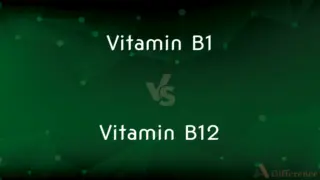Flat Water vs. Still Water — What's the Difference?
By Maham Liaqat & Fiza Rafique — Published on March 8, 2024
Flat water and still water both refer to water without carbonation, but flat water specifically denotes water that was carbonated and has lost its fizz, whereas still water naturally lacks carbonation.

Difference Between Flat Water and Still Water
Table of Contents
ADVERTISEMENT
Key Differences
Flat water typically starts as sparkling or carbonated water that has gone through a process of degassing, leading to the loss of its carbon dioxide content. This process can occur naturally over time when a carbonated drink is left open or can be induced by changes in temperature or pressure. Still water, on the other hand, is water that is naturally non-carbonated and has no added gases. It is the kind of water most commonly found in nature, such as in lakes, rivers, and most groundwater sources.
The term "flat" often carries a negative connotation, suggesting that the water is not at its intended state of quality or freshness. Bottled still water is widely available and is preferred by those who do not enjoy the taste or sensation of carbonation. It is marketed for its purity, taste, and natural mineral content, depending on the source.
The main difference between the two lies in their intended state and consumer expectations. Flat water is often seen as a diminished product because it has lost an essential characteristic—its carbonation. Meanwhile, still water is appreciated for its lack of carbonation, considered a desirable quality by those who prefer water in its most natural form.
In terms of health benefits, both flat and still water can keep a person hydrated. The choice between them often comes down to personal preference rather than health concerns. Some people may prefer the texture and slight acidity of carbonated water before it goes flat, while others may opt for the smoothness of still water.
When choosing between flat and still water, consumers typically consider the occasion and personal taste. For instance, still water is often preferred for pairing with meals or for hydration purposes, as it does not alter the taste of food. Flat water, due to its association with a loss of quality, is less commonly chosen unless options are limited.
ADVERTISEMENT
Comparison Chart
Carbonation
Originally carbonated, but lost fizz
Naturally lacks carbonation
Connotation
Negative, as it indicates a loss of quality
Neutral, often preferred for its natural state
Common Sources
Carbonated water that has been opened or exposed to air
Lakes, rivers, bottled non-carbonated water
Preferred Use
Less preferred, seen as a diminished product
Widely consumed, preferred for hydration and meals
Health Benefits
Hydrates the body, but may lack the sensory appeal of carbonation
Hydrates the body, often chosen for its purity and taste
Compare with Definitions
Flat Water
Water that has lost its carbonation, resulting in a lack of fizz.
A bottle of sparkling water left open overnight becomes flat water.
Still Water
Valued for its natural mineral content and clean taste.
Some brands of still water are sought after for their unique mineral profiles.
Flat Water
Often considered less appealing than when freshly carbonated.
Many people find the taste of flat soda or water less enjoyable.
Still Water
Often chosen to accompany food without altering taste.
Restaurants typically serve still water to guests during meals.
Flat Water
Exposure to air or temperature changes can cause carbonated water to go flat.
Sparkling water becomes flat faster when not stored properly.
Still Water
Water that has never contained added gases.
Most bottled water sold for drinking is still water.
Flat Water
Despite losing fizz, flat water can still hydrate effectively.
Flat water provides the same hydration benefits as still water.
Still Water
Effective at keeping the body hydrated without additional sensations.
Still water is a staple in hydration strategies for athletes.
Flat Water
The absence of carbonation changes the drinking experience.
The transition from sparkling to flat water is noticeable in mouthfeel and taste.
Still Water
The most common form of water, available in various sources.
Tap water in many regions is essentially still water, safe for consumption.
Flat Water
Of or on a level or slow-moving watercourse
Flat-water canoeing.
A flat-water race.
Still Water
A level section of a waterway where no current is discernible and the water is still.
Common Curiosities
Do flat water and still water taste the same?
Taste can vary based on the original carbonation level and mineral content, but both are essentially water and primarily taste different due to the presence or absence of fizz.
Is flat water bad for you?
No, flat water is not bad for you; it simply lacks the carbonation it once had but can still hydrate effectively.
How can you prevent water from going flat?
To prevent carbonated water from going flat, keep it sealed and refrigerated to slow down the degassing process.
Why might someone choose flat water?
Choice of flat water might be due to limited options or personal indifference to the loss of carbonation.
Is bottled water always considered still water?
Bottled water is typically still unless specifically labeled as sparkling or carbonated, indicating it contains added carbonation.
Is there a difference in health benefits between flat and still water?
Both provide hydration, which is essential for health, but there are no significant health differences between them beyond personal preference for carbonation.
Can flat water be re-carbonated?
Yes, flat water can be re-carbonated using a soda maker or similar carbonation device, restoring its fizzy texture.
Can still water become flat water?
No, still water is naturally non-carbonated and does not change state. Flat water specifically refers to carbonated water that has lost its fizz.
Why do people prefer still water over flat water?
People often prefer still water for its natural state, lack of altered taste from lost carbonation, and its ability to hydrate without affecting the taste of food.
What is the environmental impact of consuming flat or still water?
The impact largely depends on the packaging and sourcing of the water. Reusable containers and sustainable water sources reduce environmental impact compared to single-use plastic bottles.
Share Your Discovery

Previous Comparison
Also vs. As Well
Next Comparison
Vitamin B1 vs. Vitamin B12Author Spotlight
Written by
Maham LiaqatCo-written by
Fiza RafiqueFiza Rafique is a skilled content writer at AskDifference.com, where she meticulously refines and enhances written pieces. Drawing from her vast editorial expertise, Fiza ensures clarity, accuracy, and precision in every article. Passionate about language, she continually seeks to elevate the quality of content for readers worldwide.













































